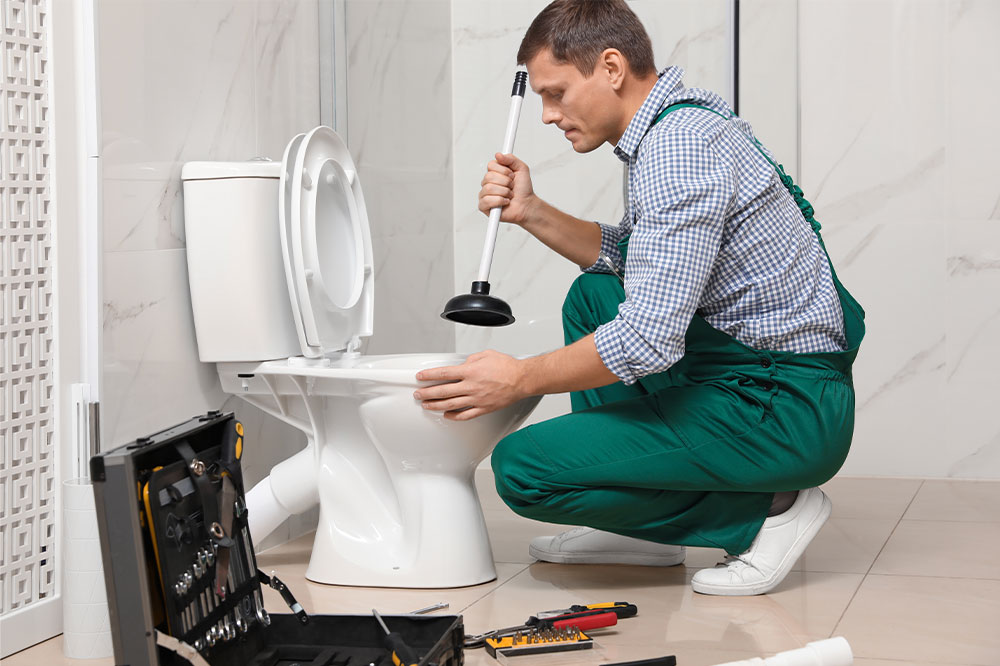
5 ways to unclog the toilet with and without tools
Unclogging a toilet is rated as one of the most complex and hated household chores. Most don’t put too much thought into it until the day it happens. There are multiple methods to unclog your toilet. Whether your toilet clogs or not, it makes sense to be prepared to have some handy tools and know the basics of what to do when the unthinkable happens. Here are five simple ways to unclog a toilet:
Plunger
A plunger is an essential tool that contains a rubber suction cap attached to a plastic or wooden stick. It is a must-have in every household and does not occupy too much space. There are three types of plungers – cup, flange, and accordion. The flange plunger is best suited for unclogging toilets as it is an all-purpose plunger. Here are instructions on how to use a plunger:
A plunger works best if the toilet has adequate water. Add water to cover the base of the plunger if it has less, and remove some if the toilet is overflowing. Insert the plunger at a 45 degrees angle, position the cup at the bottom of the toilet and make a tight seal. Now move the plunger to a 90 degrees position so the handle is straight. Push it gently downward about three or four times until the water level goes down. Ensure that the seal remains tightly closed. If the water level goes down, the plunger has worked. Now remove it and flush the toilet. If you see any solid object that is causing the clog, remove and discard it.
Toilet Auger
A closet auger is similar to a drain snake but only shorter. It is a hand tool with a metal cable attached to a rotating handle on one end, and a long tube with a smooth angle on the bottom end. It is covered with a rubber sleeve to prevent scratches on the toilet bowl. Here is a step-by-step guide to using a toilet auger:
Pull the handle of the auger so that the end of the cable is close to the bottom end. Hold the auger in one hand and insert it into the toilet. Use the other hand to crank the auger so the cable goes into the drain. Crank it slowly without force till the cable goes all the way into the toilet. If the cable is not moving, rotate the handle in the other direction. Repeat this until you feel a clog’s resistance, dislodge it, and break it down. Once the cable pushes through the clog, remove the auger gently backward. Flush the toilet well and clean and dry the auger.
Baking soda and vinegar
Baking soda and vinegar are must-have items in your pantry, as this combination comes in handy for various cleaning chores. You can use this combination if you don’t have a plunger at home. Drop one cup of baking soda into the toilet and wait for a few minutes. Add twice the amount of vinegar and wait for some time as the mixture begins to bubble. Wait some more time and flush to check if the clog has cleared.
Toilet unclogging products
If none of these ideas work, you can find many effective products to help unclog toilets. Some of them are Thrift T-600, RID – X Septic Tank Enzyme Treatment, Bio-clean drain, Green Gobbler Ultimate drain cleaner, and Drano Max Gel Clog Remover.
Plumber
If you cannot remove the clog by any of the above methods, use the services of a professional plumber who can analyze the problem and complete the job efficiently with a minor mess.
Tips to unclog the toilet
Some valuable tips to prevent clogging and unclogging toilets are:
Stop the overflow first
One of your first responses should be to prevent overflow, as the water could rise to the top and spill over to the bathroom floor. Immediately turn the water supply off by turning the shut-off valve or closing the flapper, which enables water flow.
Use protective gear
Wear gloves, a mask, and a protective apron to protect yourself from splashes. Cover the floor with a waste cloth or newspapers. Also, keep a dustbin close by.
Sensitize family about clog
Talking to your family and kids and teaching them good toilet habits can help prevent clogging. Place a dustbin in the toilet so that they learn to dispose of waste material correctly. Avoid throwing things into the toilet, which can cause cloggings, such as baby wipes, paper towels, tissues, cotton pads, cotton products, condoms, diapers, menstrual products, hair, gum, cat litter, food items, and bleach.
Keep unclogging tools clean and dry
After using them to unclog a toilet, wash and rinse the tools thoroughly using disinfectants and bleaching agents. Dry them well, cover them in a fabric or plastic bag, and store them in an accessible place.




